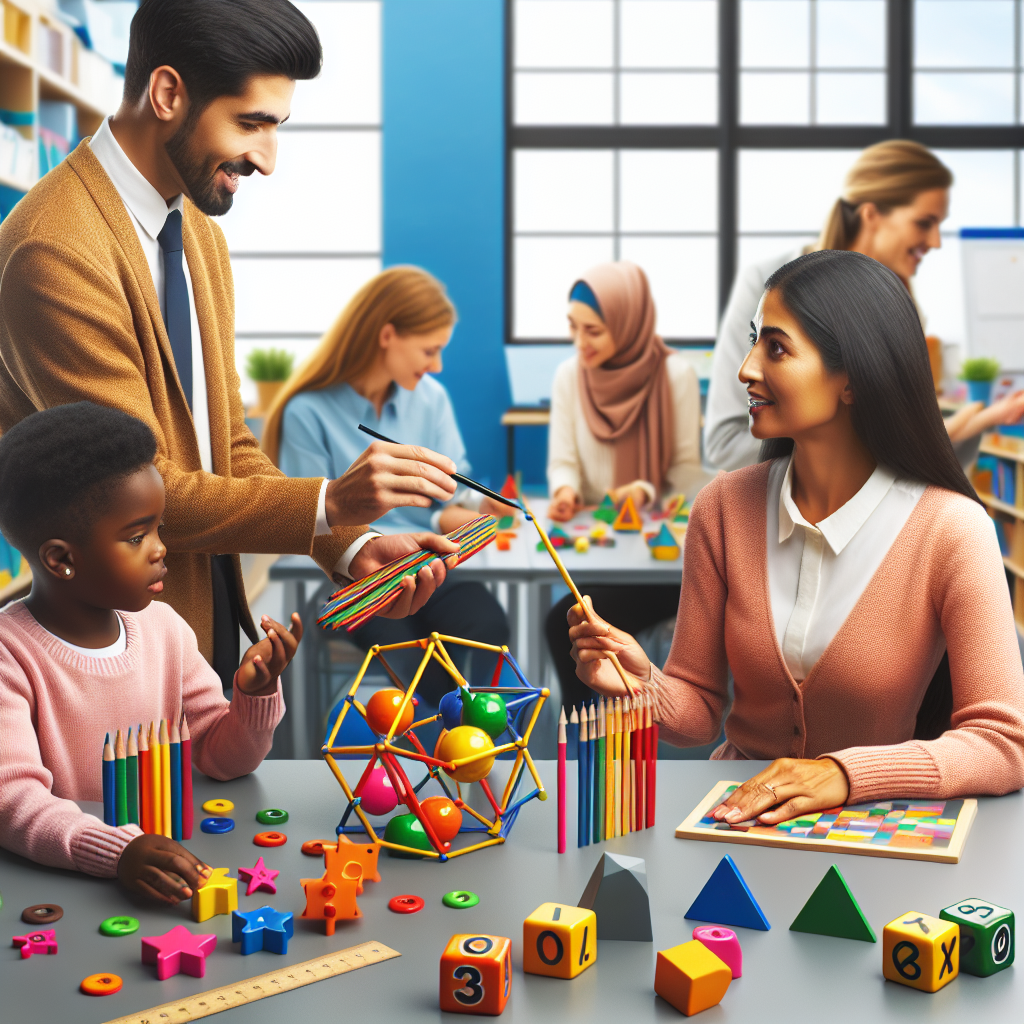In the world of education, making learning tangible can often be the key to unlocking a child’s full potential. This is where manipulatives come into play. These hands-on tools not only make abstract concepts concrete but also foster engagement and deeper understanding. This blog post will explore why educators are increasingly turning to manipulatives and how these tools are beneficial across various subjects like English and mathematics. We’ll also look into what children learn from using manipulatives and how they can revolutionize your teaching approach.
Why Manipulatives Matter in Modern Education
Manipulatives are physical objects that students can use to visualize and understand abstract concepts. They range from blocks and counters to more sophisticated items like algebra tiles and geometric shapes. The use of manipulatives has been supported by numerous studies and expert opinions, emphasizing their critical role in enhancing student learning.
Research consistently shows that students who use manipulatives tend to have a better grasp of complex concepts. This is because manipulatives help bridge the gap between concrete experiences and abstract thinking, making it easier for students to understand and retain information.
The Historical Roots of Manipulatives
The concept of using manipulatives in education isn’t new. It dates back to the early 20th century when educational theorists like Maria Montessori and Friedrich Froebel advocated for hands-on learning. They believed that children learn best when they can manipulate objects and see the results of their actions.
Fast forward to today, and this idea still holds strong. Modern classrooms around the world incorporate manipulatives as a staple in teaching various subjects. From simple counting beads in kindergarten to complex molecular models in high school, manipulatives are everywhere.
The Science Behind Manipulatives
Understanding why manipulatives are effective requires a look at cognitive science. When students use manipulatives, they engage multiple senses, which helps to solidify learning. According to Piaget’s theory of cognitive development, children move from concrete operational stages to more abstract thinking. Manipulatives serve as a bridge in this transition, providing a concrete foundation on which abstract concepts can be built.
Studies have shown that students using manipulatives perform better in problem-solving tasks and have improved retention rates. This is because the tactile experience of handling physical objects creates a stronger memory trace compared to just hearing or reading about a concept.
Benefits of Using Manipulatives in the Classroom
Enhanced Engagement
One of the most significant benefits of using manipulatives is increased student engagement. When students can touch, move, and experiment with objects, they are more likely to stay focused and interested in the lesson.
Manipulatives turn passive learning into active exploration. For example, instead of merely listening to a lecture on fractions, students can use fraction circles to visualize and manipulate parts of a whole. This hands-on approach makes the learning experience more enjoyable and memorable.
Improved Understanding
Manipulatives help break down complex concepts into manageable parts. This is especially useful in subjects like mathematics, where abstract ideas can be challenging to grasp. By providing a visual and tactile representation of a concept, manipulatives make it easier for students to understand and internalize information.
For instance, using base-ten blocks can help students understand place value and arithmetic operations. When students physically build and deconstruct numbers, they gain a clearer understanding of how numbers work together.
Development of Critical Thinking Skills
Manipulatives encourage students to think critically and problem-solve. When using these tools, students often have to figure out how to use them to represent a concept or solve a problem. This process fosters critical thinking and analytical skills.
For example, when solving a geometry problem using geometric shapes, students must determine which shapes to use and how to arrange them to form a specific figure. This type of problem-solving activity enhances their spatial reasoning and critical thinking abilities.
Manipulatives in Teaching English
Vocabulary Building
Manipulatives can be instrumental in teaching English, particularly in building vocabulary. Using objects like flashcards, letter tiles, and word puzzles can make learning new words more interactive and fun.
For example, letter tiles can be used to form words, helping students understand spelling patterns and word structures. This hands-on approach reinforces vocabulary learning and aids in memory retention.
Grammar and Sentence Structure
Manipulatives can also help in teaching grammar and sentence structure. Tools like sentence strips, word cards, and punctuation markers can make abstract grammar rules tangible.
Students can physically manipulate words and punctuation to form sentences, helping them understand the mechanics of grammar. This interactive approach makes learning grammar more engaging and accessible.
Reading Comprehension
Reading comprehension can be enhanced using manipulatives like story maps, character cards, and event sequencing charts. These tools help students visualize the narrative structure and improve their understanding of the text.
For instance, using a story map, students can break down a story into its main components—setting, characters, problem, and solution. This visual representation aids in comprehension and retention of the story.
Manipulatives in Mathematics Education
Conceptual Understanding
In mathematics, manipulatives are invaluable for building conceptual understanding. Tools like number lines, fraction circles, and algebra tiles make abstract math concepts concrete and understandable.
For example, algebra tiles can help students visualize and solve algebraic equations. By manipulating the tiles to represent variables and constants, students gain a deeper understanding of algebraic principles.
Problem-Solving
Manipulatives also enhance problem-solving skills in mathematics. They provide a hands-on way for students to explore different strategies and find solutions to problems.
When solving a word problem, students can use manipulatives like counters or blocks to represent the quantities involved. This visual representation helps them understand the problem and find a solution more effectively.
Real-World Applications
Using manipulatives in math education helps students see the real-world applications of mathematical concepts. For example, using money manipulatives can teach students about financial literacy and practical math skills.
By simulating real-world scenarios, manipulatives make math more relevant and meaningful. Students can see how the concepts they learn in the classroom apply to everyday life.
What Children Learn from Manipulatives
Fine Motor Skills
Using manipulatives helps develop fine motor skills in young children. Activities like sorting, stacking, and building require precise hand movements, which improve hand-eye coordination and dexterity.
For example, stacking blocks or threading beads helps children develop the fine motor skills needed for writing and other tasks.
Cognitive Development
Manipulatives support cognitive development by encouraging children to think critically and solve problems. These tools engage multiple senses, making learning more effective and memorable.
When children use manipulatives, they engage in hands-on exploration and experimentation. This process enhances their cognitive development and helps them build a strong foundation for future learning.
Social Skills
Manipulatives can also promote social skills by encouraging collaboration and communication. Group activities involving manipulatives require students to work together, share ideas, and communicate effectively.
For example, building a structure with blocks as a team requires cooperation and communication. This collaborative experience helps students develop essential social skills.
Practical Tips for Integrating Manipulatives
Start Simple
When introducing manipulatives, start with simple tools and activities. Gradually increase the complexity as students become more comfortable with using them.
For example, start with basic counting beads for young children and gradually introduce more complex manipulatives like fraction circles and algebra tiles.
Encourage Exploration
Give students time to explore and experiment with manipulatives. Encourage them to try different strategies and find their own solutions to problems.
For instance, during a math lesson, allow students to use manipulatives to explore different ways to solve a problem. This hands-on exploration fosters creativity and critical thinking.
Provide Clear Instructions
While it’s important to encourage exploration, also provide clear instructions and guidance on how to use manipulatives effectively. Demonstrate how to use the tools and provide examples to help students understand their purpose.
For example, during a lesson on fractions, demonstrate how to use fraction circles to represent different fractions. This clear instruction helps students understand how to use the manipulatives effectively.
Common Challenges and Solutions
Limited Resources
One common challenge in using manipulatives is limited resources. Not all schools have access to a wide variety of manipulatives.
To overcome this challenge, consider creating DIY manipulatives using everyday items like buttons, paper clips, and plastic containers. These inexpensive alternatives can be just as effective as commercial manipulatives.
Time Constraints
Another challenge is finding time to integrate manipulatives into the curriculum. With a packed schedule, it can be difficult to allocate time for hands-on activities.
To address this issue, look for opportunities to incorporate manipulatives into existing lessons. For example, use manipulatives during math centers or as part of small group activities.
Student Resistance
Some students may initially resist using manipulatives, especially if they are used to traditional learning methods. To overcome this resistance, explain the benefits of manipulatives and how they can enhance learning.
Provide positive reinforcement and encouragement to help students see the value of using manipulatives. Gradually increase the complexity of activities to build their confidence and comfort level.
Success Stories from Educators
Case Study 1: Transforming Math Lessons
Sarah, a fifth-grade teacher, struggled to keep her students engaged during math lessons. She decided to introduce manipulatives like base-ten blocks and fraction circles to make lessons more interactive.
The impact was immediate. Students became more engaged and enthusiastic about math. They could visualize mathematical concepts and solve problems more effectively. Sarah observed a significant improvement in their understanding and performance.
Case Study 2: Enhancing Vocabulary Learning
Emily, an ESL teacher, used manipulatives like letter tiles and word puzzles to teach vocabulary to her students. The hands-on activities made learning new words fun and interactive.
Students were excited to use the manipulatives and actively participated in the lessons. Emily noticed an improvement in their vocabulary retention and usage. The manipulatives helped bridge the language gap and made learning more accessible.
Case Study 3: Building Social Skills
Mark, a kindergarten teacher, used manipulatives like building blocks and sorting materials to promote social skills among his students. Group activities involving manipulatives encouraged collaboration and communication.
Students learned to work together, share ideas, and communicate effectively. Mark observed improved social interactions and teamwork among his students. The manipulatives created a positive and inclusive learning environment.
Conclusion
Manipulatives are powerful tools that can transform the learning experience for students of all ages. By making abstract concepts concrete, manipulatives enhance engagement, understanding, and critical thinking skills. They have proven benefits in subjects like English and mathematics and support cognitive, fine motor, and social development.
Integrating manipulatives into your teaching practice can be a game-changer. Start simple, encourage exploration, and provide clear instructions to maximize their effectiveness. Overcome challenges with creative solutions and witness the positive impact on your students’ learning.


